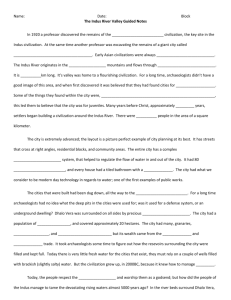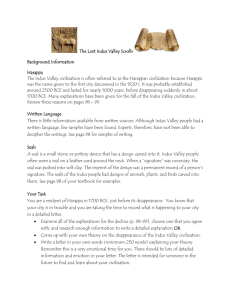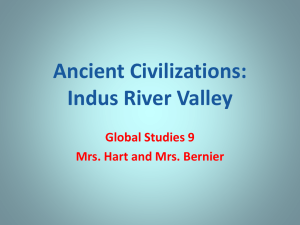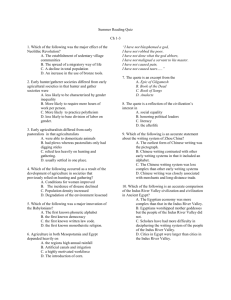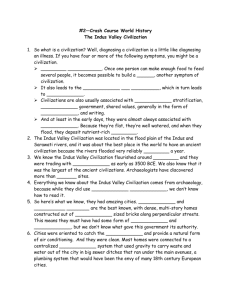Gale_Artifact Box Handout
advertisement
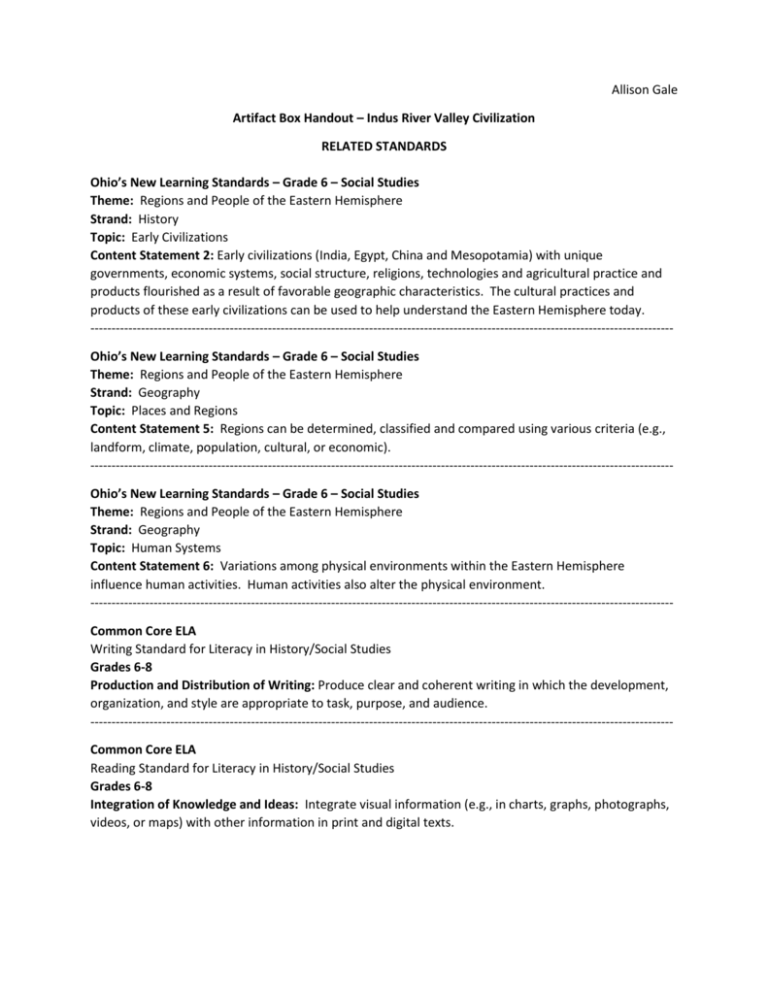
Allison Gale Artifact Box Handout – Indus River Valley Civilization RELATED STANDARDS Ohio’s New Learning Standards – Grade 6 – Social Studies Theme: Regions and People of the Eastern Hemisphere Strand: History Topic: Early Civilizations Content Statement 2: Early civilizations (India, Egypt, China and Mesopotamia) with unique governments, economic systems, social structure, religions, technologies and agricultural practice and products flourished as a result of favorable geographic characteristics. The cultural practices and products of these early civilizations can be used to help understand the Eastern Hemisphere today. -----------------------------------------------------------------------------------------------------------------------------------------Ohio’s New Learning Standards – Grade 6 – Social Studies Theme: Regions and People of the Eastern Hemisphere Strand: Geography Topic: Places and Regions Content Statement 5: Regions can be determined, classified and compared using various criteria (e.g., landform, climate, population, cultural, or economic). -----------------------------------------------------------------------------------------------------------------------------------------Ohio’s New Learning Standards – Grade 6 – Social Studies Theme: Regions and People of the Eastern Hemisphere Strand: Geography Topic: Human Systems Content Statement 6: Variations among physical environments within the Eastern Hemisphere influence human activities. Human activities also alter the physical environment. -----------------------------------------------------------------------------------------------------------------------------------------Common Core ELA Writing Standard for Literacy in History/Social Studies Grades 6-8 Production and Distribution of Writing: Produce clear and coherent writing in which the development, organization, and style are appropriate to task, purpose, and audience. -----------------------------------------------------------------------------------------------------------------------------------------Common Core ELA Reading Standard for Literacy in History/Social Studies Grades 6-8 Integration of Knowledge and Ideas: Integrate visual information (e.g., in charts, graphs, photographs, videos, or maps) with other information in print and digital texts. Introduction – Indus River Valley Civilization – Ancient India The Indus River Valley Civilization flourished from approximately 2600 BCE – 1500 BCE in present day Pakistan. While it is one of the world’s oldest civilizations, ancient ruins were not discovered until the 1920’s. Thus, there is still much information about the civilization that has yet to be determined especially since their written language, called Indus Script, has not been decoded. This civilization thrived for approximately 1,000 years and was located by a lush alluvial fan which received its water from melting ice from Himalaya Mountains to the North and heavy summer monsoon rains. Because of the common floodwaters, Indus River Valley people built cities with 5 foot thick walls. The walls were made out of baked clay bricks that were always the same ratio in size of 1:2:4 (ex: 7cm x 14 cm x 28 cm). Their cities had plumbing and sewage systems and they were very concerned with cleanliness as they had bathrooms in every house and a large bath near the center of the village. Not only were they very precise in their building materials, but the Indus Valley people were among the first to use balance scales using stone weights. They would trade goods such as ceramic jewelry, mirrors, grain and copper with nearby Mesopotamia by land and sea. On land, they would use elephants, bulls, and camels which would pull carts to transport the goods and on sea they would use flat bottom boats to move goods up the Persian Gulf. Since there is still much to discover about the Indus Valley River Civilization, it is hard to determine why archeologists have found many seals, or clay squares with images drawn on them in the Indus Valley and Mesopotamia. They could have been used in trade as in money or simply as a symbol of trade. The social structure of the Indus River Valley Civilization is hard to decipher as remains of bodies are found without telling signs. The structure of the cities, so far as discovered today, supports a type of egalitarian society. But, later on when the Aryans moved to the Indus Valley, a caste system or social leveled system was discovered. Much still remains to be uncovered by archeologists and interpreted as we do not have a single piece of evidence that shows what happened to the civilization and why they moved. Some believe since the river was the lifeblood of the valley, once it dried up the people were forced to leave. One of the most intriguing aspects of the Indus River Valley Civilization is the quest to learn more from the archeological remains about this advanced civilization. Artifacts Brick Box – Way of Life - Place The Indus River Valley people lived in cities made from clay bricks which were baked in a kiln. The dimensions of the bricks were very exact and were always in the ration of 1:2:4. The cities were shaped like a square with an approximately five food deep wall to keep the flood waters out along with intruders such as tigers. Once the flood waters would receded, it would leave behind fertile soil which they would use to grow their crops. Teaching Idea: Throughout the River Valley Civilization unit, students would get the opportunity to add important words that were foundations for the civilization to the box. At the end of each class period, groups could come together to pick out the word they felt was most important from the lesson in describing the civilization and provide a statement of support as to why. The class would determine, as a whole, which word is most important and that group would write it in one of the bricks on the box. At the end of the unit, students would have to write a story using all of the important words on the box (incorporation of common core standard). Map – Location The map has a small world map in the upper corner which shows the location on a global scale. Then, the larger map zooms in on the area and shows India with the Ancient Indus River where modern day Pakistan is. The Himalayas are to the North of the Ancient Indus River and it flows out into the Arabian Sea. The river is the most important aspect of this civilization as it is the lifeblood of the people for crops, trade, and travel. Currently, the river is dried up and some archeologists think the reason the Indus Valley people moved is because the river dried up. Teaching Idea: Students can use this map and others they find online as a guide to create their own map on a large Eastern Hemisphere map. Then, as they continue to make their own maps of each civilization, such as Mesopotamia, they can draw in lines of trade that the ancient people may have traveled. They can also label regions. Clay Drainpipe – Place – Human Features/Interactions One of the most amazing discoveries of the Indus River Valley Civilization is that the people were so advanced that they had indoor plumbing and sewage systems made of clay. This is thought to have existed thousands of years before other civilizations. The pipes ran through each house and connected to larger covered drain-ways or sewers that carried waste outside of the city. It seems that almost every house had a bathroom which leads historians to believe that the Indus Valley civilization was very concerned with cleanliness and wanted to keep disease away. Teaching Idea: There are two ways the drain-pipe can be used in the classroom. First, it can be used as an activity where you ask a question about the civilization and play music while students think of the answer and pass the drain-pipe. If they have the artifact in their hand when the music stops, they will share their answer with the class. The second teaching idea is to allow students to research exactly what a drain-pipe is and the benefits of it. Then, you can ask students to imagine life in the Indus Valley without the drain-pipes and what might have been different. Students can draw a picture of the perceived outcomes or create a radio show that reveals what they believe might have happened such as disease or flooding. Seal – Place – Human Features/Interactions - Movement In the ancient Indus Valley, seals, or images impressed into soft clay were found. Many of the seals had writing, or Indus Script along with images of animals on them such as unicorns, bulls, elephants, or rhinoceros. It is suggested these seals were used in trade as they were also found in Mesopotamia. Because the written language has yet to be decoded, it is unknown what the symbols and inscriptions mean. Teaching Idea: After learning about some of the aspects of the Indus River Valley life, students can create their own seal in clay with symbols that represent the culture. Then, they can write a small “caption” of what the seal is showing. After all students make their seals, you can place them around the room in a museum style and have the students do a “museum walk” as they learn about other seals and read the captions. Bracelet – Beads – Human Interaction/Movement Fine arts were an important part of the Indus River Valley people as noted by the many beads and jewelry discovered by archeologists. They found evidence that the Indus people wore many beads made from stone, shells, and gold. The intricate designs and range of colors indicate that jewelry was and important piece of their culture. Teaching Idea: Students can make their own “jewelry” in the form of chain link colored paper they can wear. On each link, students can draw a picture of something important to the Indus River Valley people and make their own art. If you have access to an oven, or are willing to take clay home and bake it, you can have the students make their own beads. Then bring them back in for them to use string to create their own jewelry as a symbol of their learning. Scale – Science & Technology The Indus Valley people used balance scales in trade to weigh goods being transferred. They used cubes of rock as the control of weight on one side and the goods would be placed on the other side. The accuracy of their measurements were very intricate as their smallest unit of measure was less than one gram and the largest unit of measure was over 11 kilograms. This technology depicts the mathematics nature of this civilization as they focused on ratios in their brick building and measured length to 0.06 inches, the smallest unit of measurement discovered at that time. Teaching Idea: This would be a great opportunity for an inquiry learning lesson. Give students goods and ask them trade with one another without giving the goods values. See if they can determine how to “measure” a fair trade. Then, allow them to research and discover how the Indus River Valley civilization conducted trade with a balance. Ask them to compare that system of trade to the one we currently use. How is it the same? How is it different? Ask students to act out a “trade” between the Indus river people and Mesopotamia. What would it look like and what would they trade? Sources Ancient civilizations for kids. (n.d.). Retrieved July 12, 2014, from https://sites.google.com/site/1ancientcivilizationsforkids/ancient-india BBC. (n.d.). Primary history Indus Valley. Retrieved July 12, 2014, from http://www.bbc.co.uk/schools/primaryhistory/indus_valley/ Harappa. (n.d.). The ancient Indus civilization. Retrieved July 12, 2014, from http://www.harappa.com/har/indus-saraswati.html Indus valley civilization. (2014, April 15). Retrieved July 12, 2014, from https://www.newworldencyclopedia.org/entry/Indus_Valley_Civilization Richardson, H. (2005). Life in the Ancient Indus River Valley. New York, NY: Crabtree Publishing Company. ushistory.org. (2014). Early civilization in the Indus Valley. Retrieved July 12, 2014, from http://www.ushistory.org/civ/8a.asp https://docs.google.com/document/d/1LosP2mzSLnlTqYmUOZ24vyTTWBcdv4bPwoKnD3ZojvY/ edit?usp=sharing


![Indus[1] - ridgeaphistory](http://s3.studylib.net/store/data/006736077_1-c59280ecd30594bac8ab21ec7bce4db4-300x300.png)

